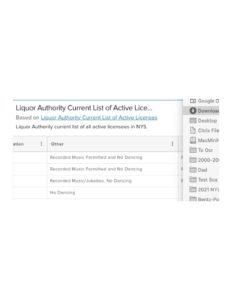The New York State Liquor Authority is the dominant regulator of music and dancing in New York City. Reform of the zoning law will not remove the SLA regulation. Over 1900 liquor licenses in New York City require licensed venues to prohibit dancing; over 3880 license do not allow live music.
We have completed a preliminary analysis of the NY SLA license database at https://data.ny.gov/Economic-Development/Liquor-Authority-Current-List-of-Active-Licenses/hrvs-fxs2/data.
It is clear that modifying the zoning will not resolve the problem of excessive regulation of dancing and music in New York City.
See The New York State Liquor Authority & Regulation of Music and Dancing by Method of Operation.
We looked at just the 5 counties in New York and then filtered out license types such as grocery stores, liquor stores, etc. leaving about 8600 licenses. We then filtered the information in the “Days/Hours of Operation” column and the “Other Column”, which together appear to describe the Method of Operation under the license. It is not clear which conditions are a result of CB Stipulations and which are a result of the Method of Operation form submitted with the license.
| Liquor Licenses in New York City. | 15,685 |
| Eating and Drinking Establishment On-Premises Licenses. | 11,257 |
| Licenses prohibiting dancing. | 2,401 |
| Licenses Allowing Patron Dancing | 265 |
| Licenses explicitly allowing Live Music | 1056 |
| Live Music Licenses With Conditions Such as Acoustic, Number of Musicians, Type of Musical Instruments, Private Events etc. | ~300 |
| Licenses Explicitly/Implicitly Prohibiting Live Music | 5,005 |
| Licenses Explicitly Prohibiting Live Music. | 600 |
| Licenses Implicitly Prohibiting Live Music since not “Recorded” music | 4,405 |
| Licenses silent as to music and patron dancing. | 7,883 |
About half of the license have no conditions relating to music or dancing. Approximately 5500 licenses do not allow live music, with 600 explicit prohibitions: 1056 licenses explicitly allow live music.
Concerning dancing, 2400 licenses explicitly prohibit dancing; only 265 licenses specifically allow “patron dancing.”
The SLA actively participates in M.A.R.C.H. to enforce the Method of Operations provisions. M.A.R.C.H. is a program managed by the Mayor’s Office with the N.Y.P.D. and DOB as partners. The Community Boards are also entities of the City and collaborates with the SLA. It seems that many license applicants
In 1986 and 1988 the City lost two litigations (Chiasson I and Chiasson II) declaring music restrictions in the Zoning Resolution and the Cabaret Law as unconstitutional. DOB enforces the Zoning Resolution. Many of the music restrictions in the SLA Methods of Operation are in conflict with those decisions.
The Chiasson decisions are discussed in Professor Chevingy’s book, Chevigny – Gigs: Jazz and the Cabaret Laws in New York City. The Chiasson cases were brought by Local 802 of the Musicians Union and three jazz musicians.
Using the Liquor License Database to Ascertain Use Group Status of Venue:
1. First search for the venues at the SLA License database
2. Then, to identify the Zoning District, access Zola – New York City’s Zoning & Land Use Map. Insert the address of the venue in the upper left corner, and then observe in the right column the Zoning District(s) of the venue. Click on the District Name to view further information about the district, which may include a description at to the Use Group for the specific district such as ” Use Groups 5, 6, 8, 9, 10 and 12, which include most retail establishments, are permitted in C4 districts. ”
3. To determine the Use Group of a parcel, access City Planning’s Use Group Summary Unless the parcel is in Use Group 12, dancing is not allowed (exception – Hotels Use Group 10).
4. To double check the Use Group summary, access the statutory language of the Zoning Resolution, and in particular §32-10 of the Zoning Resolution, see
Uses Permitted as of Right.
5. It appears that the database entries relating to Hours and Other are often incomplete and the database cannot be relied upon.
Moreover, the database incorrectly describes the type of operation as “Method of Operation” when the Method of Operation is actually in the Hours and Other column. In other words, the database uses the phrase “Method of Operation” in a manner inconsistent to how the SLA uses the term in its application and other documents.
One may submit a FOIL request to the SLA at https://openfoil.ny.gov/#/newfoilrequest.
